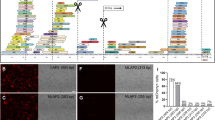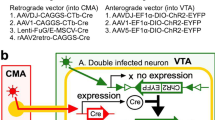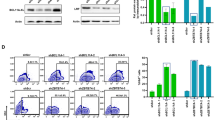Abstract
Regulated expression of therapeutic genes is required for long-term gene therapy applications for many disorders. Here we describe a doxycycline (dox)-regulated lentiviral vector system consisting of two HIV-1-based self-inactivating viruses. One of the vectors is constitutively expressing a novel improved version of the tetracycline reverse transactivator rtTA2S-M2 and the other has a rtTA responsive promoter driving the expression of β-galactosidase gene (lacZ). The rtTA2S-M2 has highly improved properties with respect to specificity, stability and inducibility. Functionality of the system by dox was confirmed after in vitro cotransduction of Chinese hamster ovary and human endothelial hybridoma (EAhy926) cells. Regulation of the system showed tight control of the gene expression. Dose dependence for dox was seen with concentrations that can be obtained in vivo with doses normally used in clinical practice. LacZ expression could be switched on/off during long-term (3 months) culturing of cotransduced cells. The system was next tested in vivo after cotransduction into rat brain and studying expression of the lacZ gene in dox-treated and control rats. Nested RT-PCR confirmed that the tight control of the gene expression was achieved in vivo. Also, X-gal staining showed positive cells in the dox-treated rats, but not in the controls 10 days after cotransduction with 4 days preceding treatment with dox. It is concluded that our doxycycline-regulated vector system shows significant potential for long-term gene therapy treatments.
This is a preview of subscription content, access via your institution
Access options
Subscribe to this journal
Receive 12 print issues and online access
$259.00 per year
only $21.58 per issue
Buy this article
- Purchase on Springer Link
- Instant access to full article PDF
Prices may be subject to local taxes which are calculated during checkout







Similar content being viewed by others
References
Ylä-Herttuala S, Martin JF . Cardiovascular gene therapy. Lancet 2000; 355: 213–222.
Gossen M, Bujard H . Tight control of gene expression in mammalian cells by tetracycline-responsive promoters. Proc Natl Acad Sci USA 1992; 89: 5547–5551.
Gossen M et al. Transcriptional activation by tetracyclines in mammalian cells. Science 1995; 268: 1766–1769.
Orth P et al. Structural basis of gene regulation by the tetracycline inducible Tet repressor-operator system. Nat Struct Biol 2000; 7: 215–219.
Baron U, Bujard H . Tet repressor-based system for regulated gene expression in eukaryotic cells: principles and advances. Methods Enzymol 2000; 327: 401–421.
Urlinger S et al. Exploring the sequence space for tetracycline-dependent transcriptional activators: novel mutations yield expanded range and sensitivity. Proc Natl Acad Sci USA 2000; 97: 7963–7968.
Baron U, Gossen M, Bujard H . Tetracycline-controlled transcription in eukaryotes: novel transactivators with graded transactivation potential. Nucleic Acids Res 1997; 25: 2723–2729.
Miyoshi H et al. Development of a self-inactivating lentivirus vector. J Virol 1998; 72: 8150–8157.
Dull T et al. A third-generation lentivirus vector with a conditional packaging system. J Virol 1998; 72: 8463–8471.
Blomer U et al. Highly efficient and sustained gene transfer in adult neurons with a lentivirus vector. J Virol 1997; 71: 6641–6649.
Kordower JH et al. Lentiviral gene transfer to the nonhuman primate brain. Exp Neurol 1999; 160: 1–16.
Naldini L et al. Efficient transfer, integration, and sustained long-term expression of the transgene in adult rat brains injected with a lentiviral vector. Proc Natl Acad Sci USA 1996; 93: 11382–11388.
Zufferey R et al. Multiply attenuated lentiviral vector achieves efficient gene delivery in vivo. Nat Biotechnol 1997; 15: 871–875.
Lai Z, Brady RO . Gene transfer into the central nervous system in vivo using a recombinanat lentivirus vector. J Neurosci Res 2002; 67: 363–371.
Miyoshi H et al. Transduction of human CD34+ cells that mediate long-term engraftment of NOD/SCID mice by HIV vectors. Science 1999; 283: 682–686.
Demaison C et al. High-level transduction and gene expression in hematopoietic repopulating cells using a human imunodeficiency virus type 1-based lentiviral vector containing an internal spleen focus forming virus promoter. Hum Gene Ther 2002; 13: 803–813.
Pawliuk R et al. Correction of sickle cell disease in transgenic mouse models by gene therapy. Science 2001; 294: 2368–2371.
Park F et al. Efficient lentiviral transduction of liver requires cell cycling in vivo. Nat Genet 2000; 24: 49–52.
Park F, Ohashi K, Kay MA . Therapeutic levels of human factor VIII and IX using HIV-1-based lentiviral vectors in mouse liver. Blood 2000; 96: 1173–1176.
Kafri T et al. Sustained expression of genes delivered directly into liver and muscle by lentiviral vectors. Nat Genet 1997; 17: 314–317.
Johnson LG et al. Pseudotyped human lentiviral vector-mediated gene transfer to airway epithelia in vivo. Gene Ther 2000; 7: 568–574.
Gallichan WS et al. Lentivirus-mediated transduction of islet grafts with interleukin 4 results in sustained gene expression and protection from insulitis. Hum Gene Ther 1998; 9: 2717–2726.
Gusella GL et al. Lentiviral gene transduction of kidney. Hum Gene Ther 2002; 13: 407–414.
Frimpong K, Spector SA . Cotransduction of nondividing cells using lentiviral vectors. Gene Ther 2000; 7: 1562–1569.
Wang Y et al. A regulatory system for use in gene transfer. Proc Natl Acad Sci USA 1994; 91: 8180–8184.
Pollock R et al. Delivery of a stringent dimerizer-regulated gene expression system in a single retroviral vector. Proc Natl Acad Sci USA 2000; 97: 13221–13226.
Rivera VM et al. A humanized system for pharmacologic control of gene expression [see comments]. Nat Med 1996; 2: 1028–1032.
No D, Yao TP, Evans RM . Ecdysone-inducible gene expression in mammalian cells and transgenic mice. Proc Natl Acad Sci USA 1996; 93: 3346–3351.
Deglon N et al. Self-inactivating lentiviral vectors with enhanced transgene expression as potential gene transfer system in Parkinson's disease. Hum Gene Ther 2000; 11: 179–190.
Vigna E et al. Robust and efficient regulation of transgene expression in vivo by improved tetracycline-dependent lentiviral vectors. Mol Ther 2002; 5: 252–261.
Lamartina S et al. Stringent control of gene expression in vivo by using novel doxycycline-dependent trans-activators. Hum Gene Ther 2002; 13: 199–210.
Ylä-Herttuala S et al. Transfer of 15-lipoxygenase gene into rabbit iliac arteries results in the appearance of oxidation-specific lipid-protein adducts characteristic of oxidized low density lipoprotein. J Clin Invest 1995; 95: 2692–2698.
Author information
Authors and Affiliations
Rights and permissions
About this article
Cite this article
Koponen, J., Kankkonen, H., Kannasto, J. et al. Doxycycline-regulated lentiviral vector system with a novel reverse transactivator rtTA2S-M2 shows a tight control of gene expression in vitro and in vivo. Gene Ther 10, 459–466 (2003). https://doi.org/10.1038/sj.gt.3301889
Received:
Accepted:
Published:
Issue Date:
DOI: https://doi.org/10.1038/sj.gt.3301889
Keywords
This article is cited by
-
An improved Tet-on system in microRNA overexpression and CRISPR/Cas9-mediated gene editing
Journal of Animal Science and Biotechnology (2019)
-
Electrophysiological Properties and Viability of Neonatal Rat Ventricular Myocyte Cultures with Inducible ChR2 Expression
Scientific Reports (2017)
-
The retroviral vector family: something for everyone
Virus Genes (2017)
-
RETRACTED: Neurotrophin 3 Transduction Augments Remyelinating and Immunomodulatory Capacity of Neural Stem Cells
Molecular Therapy (2014)
-
Conditional Expression of the Type 2 Angiotensin II Receptor in Mesenchymal Stem Cells Inhibits Neointimal Formation After Arterial Injury
Journal of Cardiovascular Translational Research (2014)



